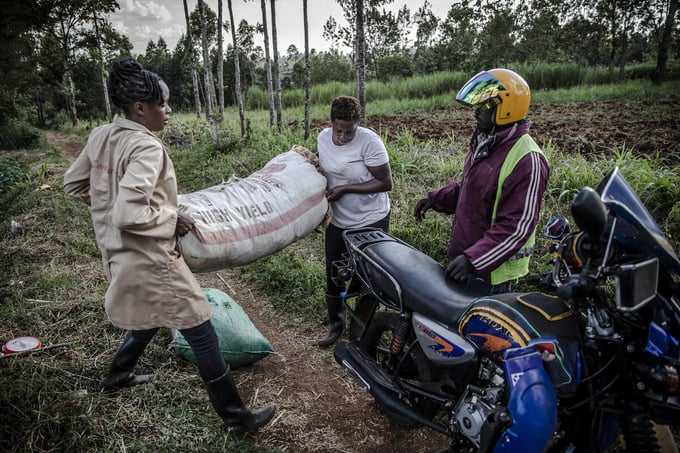November 26, 2025 | 18:27 GMT +7
November 26, 2025 | 18:27 GMT +7
Hotline: 0913.378.918
November 26, 2025 | 18:27 GMT +7
Hotline: 0913.378.918

A FAO-trained youth at work in Kenya.
Policy makers, researchers and the public have a new resource to gauge the scale and importance of agrifood systems in providing employment around the world.
The Food and Agriculture Organization of the United Nations (FAO) has launched five new indicators and overhauled the data available on its FAOSTAT portal, the global go-to resource for those interested in agrifood facts and rural livelihoods.
The expanded data domain now provides, at the country, regional and global levels, information on 23 indicators ranging from employment in agrifood systems, status in employment, divisions of agriculture and hours worked of the people employed in agriculture, forestry and fishing and in rural areas by sex and age whenever possible. Key indicators refer to agricultural and non-agricultural employment in agrifood systems and break down data by age groups, sex and sectors of agriculture including forestry and logging and fishing and aquaculture as well as hunting and crop and animal production.
“The expanded FAOSTAT responds to a critical need to improve the availability of employment data to inform the transformation of agrifood systems. It offers a better picture of how many people are working in agrifood systems around the world and highlights their key role in feeding the planet,” said José Rosero Moncayo, Chief Statistician and Director, FAO Statistics Division.
The new FAOSTAT offering gives useful insights on what is the world’s largest labor sector, employing close to 1.3 billion people, or 39.2 percent of the global work force. It also sets the stage for more detailed monitoring of trends at a local level going forward.
Some takeaways
The global share of employment in agrifood systems (AFS) has decreased significantly, from 52.2 percent in 2000 to 39.2 percent in 2021, indicating a major shift towards other sectors over the past two decades.
Africa leads with 64.5 percent of employment in AFS, highlighting a strong reliance on agrifood systems. Asia follows with 41.5 percent, reflecting both agrarian economies alongside growing industrialization. The Americas hold a 22.4 percent share in total employment, followed by Oceania at 18.7 percent, and Europe at 14.7 percent, indicating more diversified economies with a lower reliance on AFS employment.Asia recorded the highest number of people – 830 million people - working in agrifood systems, with China and India accounting for nearly 60 percent of such employment.
Africa followed with an estimated 300 million people. The two continents combined account for 88 percent of global employment in agrifood systems.
Globally, the agricultural sector makes up 67.5 percent of agrifood system employment, though regional differences are substantial. In the Americas, Europe, and Oceania, much of agrifood employment centers on off-farm activities like food processing, services, trade, transportation, and non-food agricultural manufacturing.
By contrast, Africa and Asia primarily rely on farming for agrifood jobs. Agricultural employment within agrifood systems ranges from 74.4 percent in Africa to just 34.8 percent in Europe.
Non-agricultural employment in agrifood systems (AFS) has remained stable at around 13 percent of total global employment over the past two decades, with Africa as the only region experiencing growth in this sector.
In 2021, non-agricultural AFS employment reached 16.5 percent in Africa, followed by the Americas at 12.8 percent, Asia at 12.4 percent, Oceania at 11.9 percent, and Europe, which had the lowest share at 9.6 percent.
(FAO)

(VAN) After the institutional merger, Da Nang possesses significant forest-carbon reserves and is proactively engaging in the carbon market, creating a new revenue stream.

(VAN) An Giang strengthens communication against IUU fishing, increases inspections and sanctions, and is determined to remove the EC’s “yellow card” while developing a sustainable fisheries sector.

(VAN) As green transition becomes a global trajectory, Viet Nam’s biggest challenge is not only technology and models, but how to ensure that capital flows reach the right beneficiaries.

(VAN) The Ministry of Agriculture and Environment must spearhead the construction of green governance, spanning decision-making processes and investment standards to policy evaluation mechanisms.

(VAN) The Agriculture and Environment sector of Khanh Hoa has achieved numerous milestones over the past 80 years, contributing significantly to the goal of establishing the province as a centrally governed city by 2030.

(VAN) Viet Nam is entering the pivotal period of 2025-2030, moving toward the formulation of the Remote Sensing Law, which will establish a legal foundation for the development of national digital data.

(VAN) The agricultural sector is finalizing the strategic framework for emission reduction, setting the goal of sharply cutting methane and 403.7 million tons of CO2 equivalent and moving toward Net Zero by 2050.